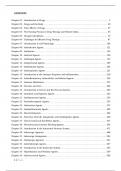Exam (elaborations)
Test Bank Focus on Nursing Pharmacology 8th Edition Karch
Test Bank Focus on Nursing Pharmacology 8th Edition KarchCONTENTS
Chapter 01 - Introduction to Drugs ................................ ........................ 2 Chapter 02 - Drugs and the Body ................................ ......................... 20 Chapter 03 - Toxic Effects of Drugs ..........
[Show more]
Preview 4 out of 977 pages
Uploaded on
April 11, 2024
Number of pages
977
Written in
2023/2024
Type
Exam (elaborations)
Contains
Questions & answers
$17.99
100% satisfaction guarantee
Immediately available after payment
Both online and in PDF
No strings attached
1 | P a g e CONTENTS Chapter01-Introduction toDrugs ................................ ........................ 2 Chapter02-DrugsandtheBody ................................ ......................... 20 Chapter03-ToxicEffectsofDrugs ................................ ....................... 37 Chapter04-TheNursingProcessinDrugTherapy andPatientSafety .......................... 55 Chapter05-DosageCalculations ................................ ......................... 72 Chapter06-Challenges toEffective DrugTherapy ................................ .......... 87 Chapter07-Introduction toCellPhysiology ................................ .............. 104 Chapter08-Antiinfective Agents ................................ ........................ 121 Chapter09-Antibiotics ................................ ................................ 139 Chapter10-Antiviral Agents ................................ ........................... 156 Chapter11-Antifungal Agents ................................ .......................... 173 Chapter12-Antiprotozoal Agents ................................ ....................... 189 Chapter13-Anthelmintic Agents ................................ ........................ 205 Chapter14-Antineoplastic Agents ................................ ...................... 221 Chapter15-Introduction totheImmune Response andInflammation ........................ 238 Chapter16-Antiinflammatory, Antiarthritis, andRelatedAgents ............................. 256 Chapter17-Immune Modulators ................................ ........................ 272 Chapter18-Vaccines andSera ................................ .......................... 289 Chapter19-Introduction toNervesandtheNervous System ................................ 306 Chapter20-Anxiolytic andHypnotic Agents ................................ .............. 322 Chapter21-Antidepressant Agents ................................ ...................... 339 Chapter22-Psychotherapeutic Agents ................................ ................... 355 Chapter23-Antiseizure Agents ................................ ......................... 372 Chapter24-Antiparkinsonism Agents ................................ ................... 389 Chapter25-MuscleRelaxants ................................ .......................... 405 Chapter26-Narcotics, Narcotic Antagonists, andAntimigraine Agents ........................ 420 Chapter27-GeneralandLocalAnesthetic Agents ................................ .......... 437 Chapter28-Neuromuscular Junction Blocking Agents ................................ ...... 454 Chapter29-Introduction totheAutonomic Nervous System ................................ . 471 Chapter30-Adrenergic Agonists ................................ ........................ 488 Chapter31-Adrenergic Antagonists ................................ ..................... 503 Chapter32-Cholinergic Agonists ................................ ....................... 521 Chapter33-Anticholinergic Agents ................................ ...................... 537 Chapter34-Introduction totheEndocrine System ................................ ......... 553 Chapter35-Hypothalamic andPituitary Agents ................................ ........... 569 Chapter36-Adrenocortical Agents ................................ ...................... 585 Chapter37-ThyroidandParathyroid Agents ................................ .............. 601 Chapter38-AgentstoControlBloodGlucoseLevels ................................ ....... 618 Chapter39-Introduction totheReproductive System ................................ ...... 635 Chapter40-DrugsAffecting theFemaleReproductive System ............................... 652 Chapter41-DrugsAffecting theMaleReproductive System ................................ . 668 Chapter42-Introduction totheCardiovascular System ................................ ..... 683 Chapter43-DrugsAffecting BloodPressure ................................ .............. 700 Chapter44-AgentsforTreating HeartFailure ................................ ............. 717 Chapter45-Antiarrhythmic Agents ................................ ...................... 733 Chapter46-Antianginal Agents ................................ ......................... 750 Chapter47-Lipid-Lowering Agents ................................ ...................... 765 Chapter48-DrugsAffecting BloodCoagulation ................................ ............ 783 Chapter49-DrugsUsedtoTreatAnemias ................................ ................ 799 Chapter50-Introduction totheRenalSystem ................................ ............. 814 Chapter51-DiureticAgents ................................ ............................ 830 Chapter52-DrugsAffecting theUrinaryTractandtheBladder .............................. 846 Chapter53-Introduction totheRespiratory System ................................ ........ 863 Chapter54-DrugsActingontheUpperRespiratory Tract ................................ ... 880 Chapter55-DrugsActingontheLowerRespiratory Tract ................................ .. 897 Chapter56-Introduction totheGastrointestinal System ................................ .... 914 Chapter57-DrugsAffecting Gastrointestinal Secretions ................................ .... 929 Chapter58-DrugsAffecting Gastrointestinal Motility ................................ ...... 945 Chapter59-Antiemetic Agents ................................ ......................... 961 Chapter 01-Introduction toDrugs Anurseworking inradiology administers iodinetoapatientwhoishavingacomputed




